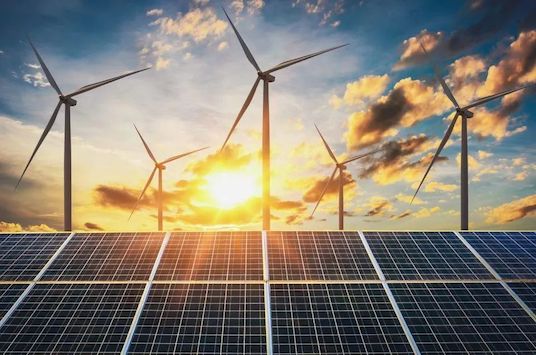 Home - Environmental monitoring - Applications - From "Dual Carbon" Goals to Carbon Inclusive: Encouraging Nationwide Participation in Carbon Reduction Actions
Home - Environmental monitoring - Applications - From "Dual Carbon" Goals to Carbon Inclusive: Encouraging Nationwide Participation in Carbon Reduction Actions
Introduction
On May 20, 2024, the China National Accreditation Service for Conformity Assessment (CNAS) issued an online notice seeking public opinions on the "Greenhouse Gas Validation and Verification Body Accreditation Program." This notice marks a step towards a more standardized and authoritative era for the greenhouse gas testing industry and provides solid technical and institutional support for China to achieve its "dual carbon" strategic goals. In this context, HealthyPhoton leveraging its leading technology and innovative products, actively responds to national policies and contributes to environmental monitoring and the carbon inclusive mechanism.
Innovation and Practice of Carbon Inclusive Mechanism
"Carbon Inclusive" is an innovative voluntary emission reduction mechanism that uses "Internet + Big Data + Carbon Finance" to quantify and value citizens' carbon reduction behaviors. By combining commercial incentives, policy encouragement, and certified emission reduction trading, the carbon inclusive mechanism mobilizes various social forces, promoting nationwide participation in energy conservation and carbon reduction actions.

Practice Models of Carbon Inclusive
Government-Led Models
1. Guangdong Province's Carbon Inclusive Model
Model Features: Quantifies users' specific low-carbon behaviors into carbon credits or Provincial Carbon Inclusive Certified Emission Reductions (PHCER).
Operation Mechanism: Merchants and organizations can collect carbon credits for policy incentives or trade in the carbon market, while PHCER can offset actual carbon emissions.
Development Outcomes: Developed a series of regulations and documents to standardize the carbon inclusive system and refined the carbon inclusive methodology.
2. Zhejiang Province's Carbon Inclusive Model
Model Features: Establishes a unified standard system to quantify the low-carbon behaviors of individuals, merchants, and organizations, awarding carbon credits to target entities.
Operation Mechanism: Carbon credits can be exchanged for benefits on platforms like Ant Forest and Tiger Recycling, attracting public participation through "policy encouragement + commercial incentives."
Development Outcomes: As the first provincial carbon inclusive application in China, it has integrated numerous online platforms, offering rich benefits.
Financial Institution-Led Models
1. CITIC Bank "Carbon Account"
Model Features: Follows the model of "collecting carbon data → measuring carbon data → accumulating carbon data → applying carbon data."
Operation Mechanism: Carbon credits of individuals or organizations can be exchanged for corresponding benefits on various platforms.
Development Prospects: With multiple standards integrated and mutual recognition, the development prospects are broad.
2. Quzhou Personal "Carbon Account"
Model Features: Led by the Quzhou Branch of the People's Bank of China, relying on "Quzhoutong" to build a personal carbon account system.
Operation Mechanism: Personal carbon credits and carbon credit can be exchanged for related financial products and services.
Development Outcomes: Highly associated with commercial bank personal accounts.
3. Alipay's "Ant Forest"
Model Features: Rewards users for green behaviors (such as green travel, reducing paper and plastic use).
Operation Mechanism: Users participate in activities to earn Ant Forest energy, which can be exchanged for environmental benefits (like planting trees or protecting oceans).
Corporate (Non-Financial) Led Models
1. State Power Investment Corporation "Low-Carbon e-Point"
Model Features: Records and quantifies employees' green low-carbon behaviors, accumulating carbon credits.
Operation Mechanism: Carbon credits are used for selecting "low-carbon experts" and employee benefits within the group.
2. NIO's "Blue Point Plan"
Model Features: Awards points for users' driving mileage, and income from certification and trading is used to issue NIO points.
Operation Mechanism: NIO points can be exchanged for related benefits, encouraging users to participate in low-carbon behaviors.

Green and Low-Carbon Lifestyle
The introduction and practice of the carbon inclusive mechanism provide new ideas and methods for achieving the "dual carbon" goals. As a high-tech enterprise, HealthyPhoton will continue to leverage its technological advantages to promote innovation and application of greenhouse gas monitoring technology, making greater contributions to addressing global climate change and achieving sustainable development.
 Tel:+86-400 961 6990 Email:info@healthyphoton.com
Add:Room 305, Building 1, Zhongchuang Science Park, Jinyuan Road, Panhuo Street, Yinzhou District, Ningbo City,China
Tel:+86-400 961 6990 Email:info@healthyphoton.com
Add:Room 305, Building 1, Zhongchuang Science Park, Jinyuan Road, Panhuo Street, Yinzhou District, Ningbo City,China


